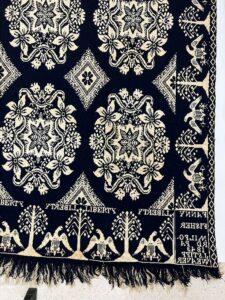
John Stiff American Coverlet
Object #: 2019.005.16
Carly Neil, Mathis Art Gallery Graduate Student Intern Fall 2023
This coverlet was accessioned into the Mathis Gallery collection in 2019. It was woven in 1843 by John Stiff in Milford, Pennsylvania. It is a great example of an early American Jacquard woven coverlet, known as “Fancy Jacquard.” Like many other early American coverlets, this example is made of undyed cotton and indigo dyed wool and constructed by piecing two panels together.
John Stiff produced this coverlet design in three different locations between 1835 and 1844. It features the LIBERTY Eagles border, a very common design element at the time with differences between various weavers. The body of the coverlet is composed of round floral motifs in 4 x 4 grid and the signature box in the lower left and lower right corner reads: FANNY FISHER, MILFORD, PA 1843, J. STIFF WEAVER.
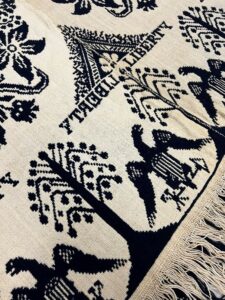
The American coverlet tradition is rich and unique. There is evidence of American coverlet weaving with overshot patterns as early as 1707. This art form became popular because it was both utilitarian and decorative. Coverlets are a definitively American weaving tradition, thought to have German origins. Many German immigrants and weavers settled in Pennsylvania, and likely brought their own weaving traditions to the US and influenced non-German weavers.
The Jacquard process is an important technological advancement for weaving. Jacquard loom technology was created by Joseph-Marie Jacquard in the early 19th century in France. In essence, Jacquard weaving is the first iteration of binary code, the earliest computer. The process operated on a series of hits and misses. Early Jacquard devices were fitted to existing looms. American looms were first fitted with Jacquard attachments in the mid 1820s. Eventually, dedicated Jacquard looms were developed for production weaving.

In its simplest form, weaving is a series of over and under. The “warp” is the vertical set of threads and the “weft” is the horizontal set of threads. Various weaving patterns are determined by the order in which warps raise and lower, revealing either a warp or weft thread on top.
This coverlet is a double woven Jacquard, sometimes known as “Fancy Jacquard.” It is composed of blocks of plain weave (over one, under one), with two layers woven at the same time. The “top” and “bottom” layer of the fabric switch sides to reveal different colors for pattern blocks. This type of weaving allows for more ornate patterns, but retains the integrity of the fabric (no floats to risk snagging).
When weaving this coverlet on the loom, each weft (also known as a pick or line) is represented by one punch card. First, the weaver would draw out the pattern on graph paper, then create punch cards based on the pattern draft. This draft would look similar to pixel art. The weaver puts the punch cards in sequence in the Jacquard device and as they move across the device the cards tell the loom which individual warps to raise. Then the weaver puts the weft thread through the opening, called the “shed” to weave. The Jacquard device reads the next card and the process goes on until the coverlet is complete.
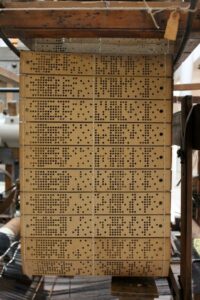
The demographics of American weavers is interesting to consider. Weaving is often thought of as women’s work in many times and locations across the globe. In the US, domestic weaving was often done by women, but the large majority of production weavers in America in the 1800s were men. There are almost 800 documented Jacquard weavers between 1835 and 1875, the majority of whom were from and/or worked in Pennsylvania. This is unsurprising considering the likely-German origins of American coverlet weaving and Pennsylvania’s concentration of German immigrants.
What we know about this coverlet’s weaver, John Stiff, is primarily based on census information and local registration records. He was born in New Jersey in 1803. He was likely an apprentice for a weaver before his first documented coverlet, which was woven in Stillwater, New Jersey in 1835. Based on extant coverlets, he continued to work in Stillwater until 1837. He then worked in Montague, New Jersey between 1838 and 1840 before moving production to Milford, Pennsylvania, where he worked between 1841 and 1844. There are no extant examples of his work beyond 1844. Stiff relocated to Independence, Michigan in 1852 and died in Fenton Township, Michigan in 1877.
Part of the lack of background on John Stiff is tied to the perceived value of textiles. Unfortunately, like Stiff, we don’t know a lot about most coverlet weavers. Woven goods are typically seen as utilitarian more than fine art. Because they are perceived as a common item, their history is seldom well recorded. However, what’s unique about American woven Fancy Jacquard coverlets is their signatures. Like this coverlet, the large majority of coverlets in this style feature two signature boxes, one in each lower corner.
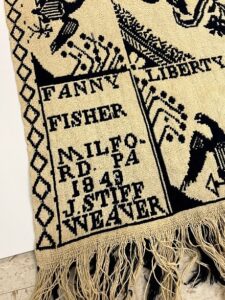
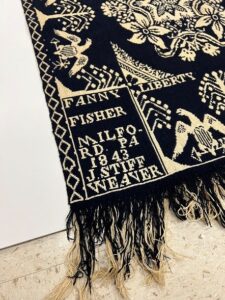
This is a unique and important practice to Jacquard coverlet weaving. The signature box allowed for makers to sign their work, and by extension offers us a window into the industry. Historians can track various weavers, recipients, and patterns across dates and locations. This practice would not have been possible without the weaving advancements of Jacquard. Next time you encounter a handwoven textile, look closely, see if you can find a maker’s mark, and contemplate the time and attention that went into the piece.
Sources:
Anderson, Clarita S. Weaving a Legacy: The Don and Jean Stuck Coverlet Collection. New York: Harry N. Abrams, Inc., 1995.
Heisey, John W. A Checklist of American Coverlet Weavers. Williamsburg: Colonial Williamsburg Foundation, 1978.
Walter, Ron. “John Stiff Coverlet Weaver.” The Newsletter of the Colonial Coverlet Guild of America, (First Quarter 2014): 1-3.